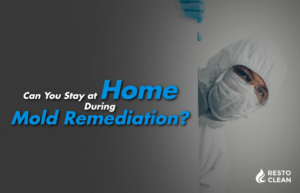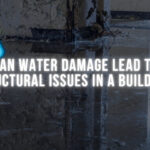
When mold makes an unwelcome appearance in your home, it can bring many concerns—from health issues to property damage. At Resto Clean, we often ask whether it’s safe to remain in your home during mold remediation. The answer depends on several factors, each of which we’ll explore to help you make an informed decision.
Understanding the Scope of the Infestation
The first thing to consider is the extent of the mold infestation. Mold can vary from a small patch in a corner to widespread growth across multiple rooms. For minor, contained areas, it might be feasible to stay home. However, vacating the premises is usually the best course of action if the mold covers a large area or is in multiple locations.
Location Matters
Where the mold is located in your home is also crucial. If the mold is confined to a basement or attic that can be easily sealed off from the rest of the house, and if proper containment measures are in place, staying might be an option. Containment includes using plastic sheeting and negative air pressure to prevent spores from spreading. However, if the mold is in common living areas, like the kitchen or bedrooms, you’ll likely need to leave it for safety and comfort.
Type of Mold
Not all molds are created equal. Some, like Stachybotrys chartarum (black mold), produce mycotoxins that can be particularly harmful. Exposure to these can cause serious health issues, especially in children, the elderly, and those with respiratory conditions or weakened immune systems. Finding alternative accommodation during remediation is generally advisable if toxic mold is present.
Health Considerations
Your health and the health of your family are paramount. Mold exposure can cause allergic reactions, respiratory issues, and other health problems. Individuals with pre-existing conditions such as asthma or allergies should be especially cautious. Even if the mold isn’t toxic, removing it can release spores into the air, potentially exacerbating health issues.
The Remediation Process
Mold remediation involves several steps that can disrupt daily life. These include:
-
-
-
- Containment: Setting up barriers to prevent the spread of mold spores.
- Removal: Physically removing mold-infested materials.
- Cleaning: Using HEPA vacuums and air scrubbers to clean surfaces and air.
- Restoration: Repairing or replacing damaged structures.
-
-
These steps generate noise, dust, and debris, making your home less habitable. The use of potent cleaning agents and chemicals can also make it uncomfortable to stay in the house.
Professional Recommendations
At Resto Clean, we prioritize your safety and peace of mind. Our professionals will thoroughly assess the mold situation in your home and provide personalized advice. If the infestation is minor and localized, we might recommend certain precautions that allow you to stay home. However, we generally advise temporary relocation for extensive or toxic mold infestations.
Conclusion
Deciding whether to stay home during mold remediation hinges on various factors, including the severity of the infestation, the type of mold, and your health. Always consult with remediation experts to get tailored advice for your situation. At Resto Clean, we are committed to restoring your home safely and efficiently, ensuring you and your family can return to a healthy living environment as soon as possible.
If you have concerns about mold in your home, contact us today. We’re here to help you navigate the remediation process with professional expertise and care.





